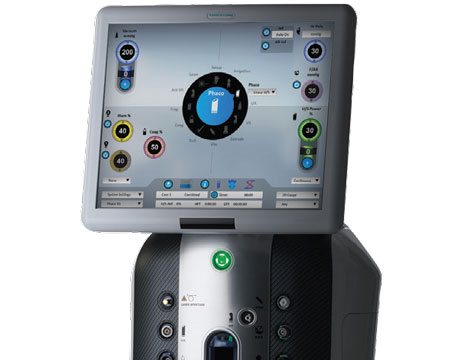The idea of using contact lenses as a tool for monitoring conditions on or inside the eye is not new, but creating such a device has been fraught with challenges. Recently, a team of researchers in Seattle headed by Babak A. Parviz, associate professor of electrical engineering at the University of Washington, working in conjunction with Tueng T. Shen, MD, PhD, assistant professor of ophthalmology and director of the refractive surgery center at the university, have successfully embedded sensors and microcircuitry into contact lenses, and been able to power them wirelessly. Early tests using a rabbit model suggest the lenses can be safe for at least short-term wear, and may be useable for numerous applications. (They reported on a prototype embedded with circuits at the 2008 meeting of the Association for Research in Vision and Ophthalmology.)
"My group's expertise is in nanofabrication—building very tiny functional devices and integrating them into unconventional substrates such as glass, plastic or even fabric," says Professor Parviz. He notes that putting contact lenses in his eyes every morning led him to think of combining the two. "We've been working on the idea since 2004," he notes. "It's feasible partly because the contact lens doesn't have to be completely transparent—just the central part—so we can position the sensors away from the visual axis. And contact lenses can easily be removed if there's a problem."
Going Wireless
One key problem with embedding circuits in a contact lens is that the circuits require power to operate. Prof. Parvis' team has solved this problem by using radio wave pulses to transmit power into the lenses from the same small transmitter that receives the data being transmitted by the lenses. "This avoids the need for an additional power source in the contact lens," Dr. Shen explains. From the receiver, the information can be broadcast to a doctor or used to trigger an alarm to alert the patient if a monitored parameter reaches a dangerous level.

Asked whether broadcasting energy to the lenses could be dangerous for the wearer, Professor Parviz admits that caution is warranted. "Fortunately, there have been a lot of studies about how much RF radiation is safe," he says. "We're all exposed to RF radiation from cell phones, TV and radio broadcasts, and even wireless Internet, just sitting in our homes. We plan to keep the power density well below those existing levels."
Dr. Shen says one of the main reasons for her interest in wireless technology is that people in less developed countries seem to be relying on cell phones for communication. "I've gone to remote areas in
Practical Concerns
Of course, any addition to a contact lens has the potential to affect the health of the eye. "We're going to great lengths to insulate our electronics from the eye itself," says Professor Parviz. "Whether the electronics will interfere with hydration or oxygen permeability will depend on the lens structure, and we'll use as permeable a lens material as possible." He says their current models are similar to rigid lenses, but they hope to move to soft lenses. "So far, we've tested lenses containing circuitry on rabbits with no adverse affects at all," he notes. "We hope to try real-time monitoring of chemicals in the tear film soon."
The next question is: What should the lenses monitor? "Some targets are obvious, but others—such as lipids and proteins—may take some time to decide upon," says Professor Parviz.
"We know this technology can monitor pH in vitro," notes Dr. Shen. "We're currently testing to see whether we can efficiently monitor other parameters in the tear film." Asked about the potential impact of the lens itself on the tear film, such as causing increased inflammation that could confound the parameters being measured, Dr. Shen notes that this isn't necessarily a bad thing. "No one has been able to continuously measure tear components to know how much inflammation is caused by contact lens wear," she says. "This approach will be able to address that question. Other tear-film parameters, such as glucose level, may not be disturbed by contact lens wear, and it's our goal to study those as well." (In any case, sensors could note an unexplained change that deserves further investigation.)
What's Next?
It may also be possible to embed an electronic display in the contact lens using tiny LEDs. Professor Parviz says he's currently working with embedded circuitry and LEDs to create very simple displays the wearer can see. "A computer-generated image would be superimposed onto your normal view," he explains. He adds that they've solved the problem of making an image up against the cornea appear clear and in focus for the wearer, but because patent issues are involved he can't provide further details.
Dr. Shen is also interested in the possibility of embedding this technology in an artificial cornea. "In my lab, we're working on polymers for the next generation of artificial corneas," she explains. "Using this kind of technology in that context would be an extension of our contact lens effort, and the benefits for people around the globe could be substantial."
In the meantime, Dr. Shen says they still have plenty of work to do on the contact lens concept. "We're very excited about the potential of the technology," she says. "We're working hard to put the functional components together, and we aim to demonstrate a functioning prototype in vivo within the next few years. Then the rest is up to whatever people can imagine using this technology."




